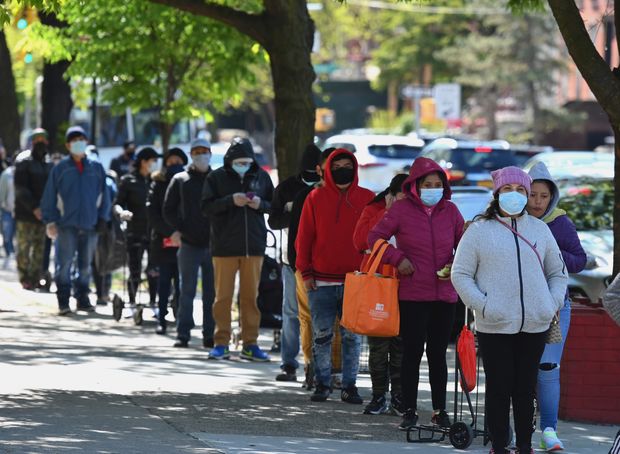
People wait in line at a food pantry in Brooklyn.
Agence France-Presse/Getty Images
The headlines this morning say that more people filed for unemployment benefits last week for the first time since March, according to the Labor Department. But the reported increase is merely a statistical mirage.
Properly viewed, job losses are essentially unchanged over the past several weeks at an extremely high level.
In the real world, slightly fewer people lost their jobs last week than the week before. The widely anticipated re-weakening in the labor market in reaction to the surge in coronavirus infections isn’t yet showing up in the weekly claims data.
The figures that were reported Thursday morning aren’t wrong, but they are misleading.
For one, the 1.42 million initial claims widely reported by the media don’t include the 975,000 people who filed for federal unemployment benefits under the CARES Act. Furthermore, the 1.42 million number has been seasonally adjusted for the typical spike of seasonal layoffs that didn’t happen this year. It doesn’t do the same with the CARES number.
So while most of the media reported that claims totaled 1.42 million last week on a seasonally adjusted basis, the Labor Department report indicates that the actual total was 2.35 million if you don’t seasonally adjust and if you include those who filed for federal benefits. That’s quite a difference!
Usually, the seasonally adjusted numbers give a better portrait of the labor market. Usually, you don’t want to be misled into thinking the economy is sinking when the apparent softness is really just the normal ebbs and flows of economic activity dictated by the calendar. You wouldn’t want to think, for example, that the economy is going into a recession every weekend when people are just taking a couple of days off.
But, as we all know, these are not usual times. The usual seasonal ebbs and flows have been disrupted. For instance, the auto makers did not shut down their factories as they usually do around the Fourth of July. But the data still get seasonally adjusted as if shutdowns did happen.
Right now, you should look at actual numbers, not those that are seasonally adjusted, to gauge the health of the labor market. And those numbers show that the number of people filing for jobless benefits isn’t changing much week to week.
In the real world, the number of claims fell slightly last week. Including claims for federal pandemic benefits, the actual number of people filing initial claims dropped from 2.45 million to 2.35 million in the week ending July 18. A month ago, that figure was 2.34 million.
According to the actual weekly claims data, the labor market has not weakened recently in response to new social distancing guidelines from local governments and private businesses. That may happen soon. But Thursday’s report doesn’t show it.
Rex Nutting has been covering money and power for MarketWatch for 23 years.










Add Comment